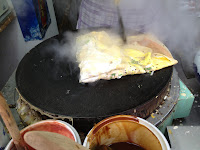There're certain dishes that I often associate with individual people around me. It's usually because of a person's love of a dish - or in some cases aversion to a dish - that gives me this association. I used to have a Taiwanese friend here in Cincinnati called Willy who absolutely loved all kinds of baked custards - custard tart, crème caramel,
crème brûlée, etc. Initially, I was secretly shocked by how much he loved his custards especially since he didn't have a sweet tooth in general. He was also something of a purist in the sense that preferred pure eggy custards to flavoured ones. I really treasured Willy's friendship but he moved back to Taiwan a while ago. I continue to think of the time I spent with him and his friends in Cincinnati even though I cannot bake these custards again for him for some time.
Crème caramel is wonderfully simple to make but yields maximum deliciousness. You make a caramel, pour it onto individual ramekins, add custard on top and bake the ramekins in a water-bath in the oven. After a good chill in the fridge, you run a knife round the edges and invert the whole thing to serve so that the caramel (which by then has re-liquefied) runs seductively around the custard. It's amazing how a little caramel could elevate a simple baked custard to undreamt-of heights.
I'm offering two versions here: plain and coffee-flavoured. For the plain version, I use extra egg yolks to boost the custardy flavour; for the coffee version, I replace part of the milk with strong espresso and stick with whole eggs. It's really worth seeking the best eggs and milk you can find for the plain version. In either case, I've kept the sugar in the custard to a minimum since the caramel sweetens it plenty anyway.
Incidentally, it seems that people in the States don't really know these custards by their French name 'crème caramel'. I've always called them crème caramel and my friends always give me a bewildered look for that. Apparently 'flan' is how they're known here, like in Latin countries.
A few observations:
1. It's better to bake these custards in the lower third of the oven. In the past when I baked them in the centre of the oven, the top half of the custards was overbaked and wasn't as smooth as the part that was submerged in the water. You want heat to be away from the custards as much as you can.
2. You can steam these custards rather than bake them if you wish. If you decide to go down this route, make sure that you cover each ramekin with cling film / plastic wrap before steaming or the texture will be rough.
3. Gentle baking is the key to a smooth baked custard. After the initial 10 minutes at 180C/350F, I turn the heat down to 130C/250F which is a lower temperature than most recipes. This gentler temperature ensures that the custards emerge smooth and creamy.
4. The caramel will harden upon contact with the cold ramekins. If you're really picky about getting perfectly caramel-filled bottoms, you can preheat the ramekins (in the roasting tin) in the oven first so that they'll be warm when you pour the caramel on them. Even if your caramel doesn't cover the entire surface of the base, remember it will liquidy eventually to cover the entire base (or top) by the time you serve them.
5. I like to pour fridge-cold milk into the saucepan you made the caramel with to dissolve any stubborn bits of caramel that stayed on the pan. This isn't just
frugality, but adds an extra something in the flavour of the custard itself. This also conveniently warms up the milk every so slightly to shorten the baking time.























